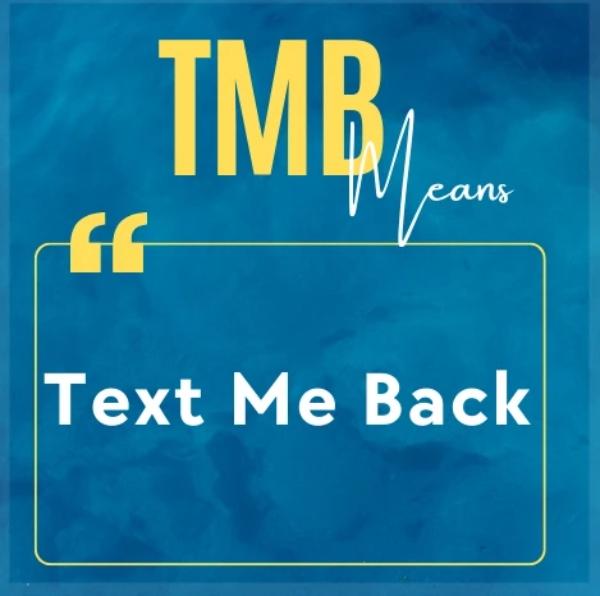The digital communication is developing rapidly. Social media, text messaging and online chats are all dominated by abbreviations and slang. However, this dependence on slang leaves many people wondering about new terms and trends. Many people have recently been asking questions like what does TMB mean and how it is used? This acronym is becoming increasingly common, but not everybody understands its meaning.
Slang is a generational phenomenon. Words liked by younger users are convenient. However, adults may misread them. So, being able to learn the most popular terms such as TMB will guarantee easier online communication. It can also assist parents to keep track of safe use of slang by teens. With the understanding of TMB meaning and usage, communication is always clear, safe and effective.
What does TMB mean?
TMB is most commonly used as a short form for “Text Me Back.” This term is an appeal to someone to respond promptly. It eliminates the work of typing out the entire sentence. It is explicit, clear and succinct.
The term usually appears at the end of the communication. It is an urgent message by the sender. It typically follows the exchange of a detail, question or reminder. Example: I require the homework notes. TMB soon.” The other is: Can you take me to class? TMB asap.”



This is a short term which is colloquial and used by young people. It could seem friendly, courteous or even plaintive, depending on the tone. In some contexts, individuals can get TMB messed up with other senses, though in the majority of text situations it indicates Text Me Back.
For example
- Informal: “Heading home now. TMB if you need something.”
- Incidental message: “Bring me my charger. TMB when free.”
- Pseudonymous communication: In the talking mood. TMB soon.”
This is flexible as seen in such cases. Tone is formed by the use of words preceding or succeeding. Out of context, its meaning can be changed. That is why the readers should be familiar with slangs in order to get the meaning correctly.
Use parental controls to track your kids digital activities.
In social media
Social media is speedy. Individuals make snap remarks or captions. In such areas, TMB conserves time and power. TMB is frequently seen on such networks as Tik Tok, Instagram, Snapchat, and Facebook.
On TikTok
On TikTok, TMB meaning is “Text Me Back.” It is a quick way to ask someone to reply or engage. Creators often use it in captions or comments to prompt interaction from their audience. Example: “Should I post part 2? Vote below, TMB.” In this case, there is a call for interaction on the phrase. It makes the viewers want to react.
There are also widespread uses expressed in Instagram comments. “Your style is amazing. TMB details.” This does not only mean to reply. It can also be used to mean send me a private message. This illustrates the ability of tone and context that lead to interpretation.
On Snapchat
On Snapchat, TMB meaning is still “Text Me Back.” It’s used to ask for a quick reply after sending a snap or message, keeping chats fast, casual, and efficient in real-time conversations. Example: “At your place now. TMB quick.” Users are used to immediate response. The short term eliminates unnecessary characters of urgency.
On Twitter
On Twitter (X), TMB usually refers to DM me or respond shortly. As an example: “Should talk about results. TMB after class.” The social sites are successful on quick interaction. Texts such as TMB transform the digital space into an interactive one.
Social media is dependent on trends. Slang such as TMB enter into the cultural language. It is used regularly, which makes it well known among the internet users. Parents or outsiders might however fail to understand the meaning. This contributes to the digital divide between generations on the Internet.
In text and messaging
These days, communication is overrun with messaging apps, such as WhatsApp, iMessage, Viber, and Messenger. Among them, TMB can be a tool in informal every-day communication. The written conversations tend to be based on speed as opposed to grammar. All in all, in texting, TMB stands for “Text Me Back,” serving as a short, casual prompt for someone to respond quickly.
The variety is shown by examples:
- Quick planning: “Leaving for gym. TMB later with schedule.”
- Urgent tasks: “Need file by tonight. TMB as soon as possible.”
- Emotional tone: “Miss you already. TMB soon please.”
These three letters convey the same meaning as opposed to full sentences. TMB might only save a few seconds, but it adds up to efficiency.
However, older generations may not recognize it. To them, Text Me back can make more sense. The use of TMB is natural among teenagers and may lead to misunderstanding with the parents or teachers. A communication gap appears when slang replaces plain language.
Context differences are easily emphasized in messaging. Incidentally, TMB among colleagues might not be professional. However, amongst siblings, it is okay. Its usage vary according to the relationship. There is always a risk and you need to make the context clear when talking to someone.
In different contexts
While most know TMB as “Text Me Back,” different industries use it differently. The identification of these secondary meanings demonstrates the significance of context when using language.
- Medicine: TMB may be an abbreviation of Tuberculosis Meningitis. Medical practitioners and scientists can utilize it in their medical records. However, in isolation, the confusion sets in. The use of texted TMB between medical professionals is obviously not the same as texting slang.
- Banking: In finance, India, TMB is a name given to “Tamilnad Mercantile Bank.” To the banking practitioners, it points to an institution, rather than slang.
- Fitness: Within the context of fitness communities, it is common to use TMB as Total Metabolic Burn. It estimates the amount of energy used in exercises.
- Gaming: In gaming, TMB may refer to certain clans, groups, or in-game phrases.
- Trading: In trading, TMB can stand for “Too Many Buyers,” describing a market situation.
These examples demonstrate why abbreviations should be clear. An abbreviation can be misleading if it’s not used correctly. Slang is clashing against the technical terms, which creates the possibility of confusion. However, consciousness prevents misunderstanding. So, never jump to conclusions by thinking about the slang meaning.
Why does TMB matter?
It is important to understand such slangs as TMB. It facilitates a better interaction among the different age groups. Indicatively, the use of slang among teens when communicating to parents results in conflict due to lack of understanding. Teen conversations frequently involve secret codes that are a concern to parents.
Digital language evolves at a quicker rate than dictionaries. Social media, memes, and group chats constantly create new phrases. Similarly, older users feel discriminated. Hence, learning slangs like TMB lessens generational differences. It enhances the digital parenting strategies also.
Unfamiliar abbreviations often cause confusion. As an example, a manager can misunderstand the TMB in a staff chat. This puts strain or makes the communication seem sloppy. Full words are usually desirable in unambiguous communication environment.
Language shortcuts have the potential to enhance or undermine relationships. Misunderstanding can result in lack of deadlines, missing duties or personal misinterpretations. Thus, it is useful to know the terms like TMB.
Parents, in particular, should be made aware. Teens use slang daily on Snapchat, TikTok, and Instagram. These words make them feel that they belong to a society. However, concealing the actual messages under abbreviations is worrisome. Knowing slang saves on panic and accusation. When parents know slang, they will be better guides.
Online safety is also enhanced by slang literacy. Predators can misuse slang words to communicate with children. Educated parents are aware of slangs and they are able to act early. They save children by knowing all the possible meanings of these abbreviations.
How to use TMB correctly
TMB works best in informal conversations. Using it at work may seem unprofessional or confusing. Slang appears naturally in casual talk but should be used thoughtfully.
Correct usage examples:
- “Finished the movie. TMB what you thought.”
- “Almost done shopping. TMB if you need snacks.”
- “Got your message. TMB once you’re free.”
Incorrect or risky usage:
- Sending “TMB” in formal business emails.
- Including “TMB” in serious academic submissions.
- Using it with people unfamiliar with common texting slang.
Repeated too frequently the abbreviation may sound impatient. For example, TMB often assumes a reply is expected. Voice in text messaging is misunderstood. Emojis or extra words can make it sound softer. Example: “TMB when you’re free with a simile face .”
Proper use depends on knowing your audience. Friends, siblings, or classmates may already know it. But professors or grandparents will not entertain it. Slang becomes personalized to make communication more effective.
Is TMB safe to use?
TMB is neither harmful on its own nor does it mean something harmful. But it seems that the wrong understanding of things is a risk. A receiver might fail to understand the slang, which will result in annoyance. This danger becomes greater in multi-generational or multi-cultural dialogues.
Adolescents can be excessive in the use of slang. They may lose their capacity of communicating effectively in formal places. This undermines the professional skills of communication in the long run. Guidance has a balance between casual and formal use.
The language of children on the internet may be very alien to the parents. Some worry that slang hides poor communication or unclear intent. Although TMB is not harmful per se, it is an indicator of the relevance of slang literacy. Hence, parents must stay updated.
Such tools as FlashGet Kids are a good source of protection. This parental control application keeps track of chat messages on the social media. It recognizes slang or suspicious conversations. This helps alert parents to risky or inappropriate conversations. These tools minimize the risks and also assist parents to protect teens in a responsible way.



Slang such as TMB is not harmful when accompanied with guidance and monitoring. It reinforces amiable dialogue without negatively affecting security.
Conclusion
TMB is an abbreviation that is most frequently used to mean Text Me Back. It is a fast informal request of a response. People mostly use it in texting and social media chats. But TMB may have a different meaning in other contexts.
Understanding slang helps prevent miscommunication. Teaching these terms to parents, professionals, and older users can reduce language barriers. Consciousness brings about a more secure online interaction and fluent dialogue.
Parents should be on the lookout of slang. TMB is harmless, however those of other people are not. Such tools as FlashGet Kids offer an advantage. They track conversations, warn parents and encourage children to use the internet in safer ways.
Effective communication requires awareness, context, and equilibrium. In a prudent manner, TMB is not harmful. It is a tool that will always be effective in online interactions with the help of guidelines and digital literacy.
FAQs
Other similar expressions are BRB (Be Right Back), LMK (Let Me Know) and IDK (I Don’t Know).
Yes. TMB has different definitions in different industries. Doctors, bankers, or parents unfamiliar with it might misunderstand the abbreviation.
Yes. However, parents ought to observe the use of slangs with tools like FlashGet Kids to keep their kids safe.

